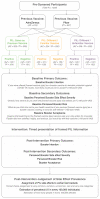Positive Attribute Framing Increases COVID-19 Booster Vaccine Intention for Unfamiliar Vaccines
- PMID: 35746570
- PMCID: PMC9229566
- DOI: 10.3390/vaccines10060962
Positive Attribute Framing Increases COVID-19 Booster Vaccine Intention for Unfamiliar Vaccines
Abstract
Positive framing has been proposed as an intervention to increase COVID-19 vaccination intentions. However, available research has examined fictitious or unfamiliar treatments. This pre-registered study (aspredicted#78369) compared the effect of standard negatively framed EU patient information leaflets (PILs), with new positively framed PILs, on booster intentions (measured pre- and post-intervention) for AstraZeneca, Pfizer, and Moderna COVID-19 vaccines. A representative sample of 1222 UK-based adults was randomised to one of six groups in a factorial design with framing (Positive vs. Negative) and vaccine familiarity (same (as previous), familiar, unfamiliar) as factors. The benefit of positive framing was hypothesised to be strongest for the least familiar vaccine (Moderna). Framing was moderated by familiarity, where only the unfamiliar vaccine showed a benefit of positive relative to negative Framing. Framing and familiarity also interacted with baseline Intention with the effect of framing on the unfamiliar vaccine especially pronounced at low baseline Intent. Conversely, standard negative framing appeared to increase intentions for familiar vaccines at low baseline intent. Findings provide important evidence that positive framing could improve vaccine uptake globally when switches or new developments require individuals to receive less familiar vaccines. Positive framing of familiar vaccines, however, should be treated with caution until better understood.
Keywords: COVID-19; attribute framing; positive framing; vaccination; vaccine hesitancy; vaccine intention.
Conflict of interest statement
The authors declare no conflict of interest.
Figures




Similar articles
-
The impact of side effect framing on COVID-19 booster vaccine intentions in an Australian sample.Vaccine. 2023 Mar 17;41(12):2046-2054. doi: 10.1016/j.vaccine.2023.02.023. Epub 2023 Feb 13. Vaccine. 2023. PMID: 36803896 Free PMC article. Clinical Trial.
-
The effect of framing and communicating COVID-19 vaccine side-effect risks on vaccine intentions for adults in the UK and the USA: A structured summary of a study protocol for a randomized controlled trial.Trials. 2021 Sep 6;22(1):592. doi: 10.1186/s13063-021-05484-2. Trials. 2021. PMID: 34488843 Free PMC article.
-
Message framing and COVID-19 vaccine acceptance among millennials in South India.PLoS One. 2022 Jul 8;17(7):e0269487. doi: 10.1371/journal.pone.0269487. eCollection 2022. PLoS One. 2022. PMID: 35802760 Free PMC article.
-
How Should Doctors Frame the Risk of a Vaccine's Adverse Side Effects? It Depends on How Trustworthy They Are.Med Decis Making. 2023 Oct-Nov;43(7-8):835-849. doi: 10.1177/0272989X231197646. Epub 2023 Sep 26. Med Decis Making. 2023. PMID: 37750570 Free PMC article.
-
COVID-19 vaccines: comparison of biological, pharmacological characteristics and adverse effects of Pfizer/BioNTech and Moderna Vaccines.Eur Rev Med Pharmacol Sci. 2021 Feb;25(3):1663-1669. doi: 10.26355/eurrev_202102_24877. Eur Rev Med Pharmacol Sci. 2021. PMID: 33629336 Review.
Cited by
-
Drivers of the Intention to Receive a COVID-19 Booster Vaccine: Insights from the UK and Australia.Vaccines (Basel). 2022 Oct 17;10(10):1730. doi: 10.3390/vaccines10101730. Vaccines (Basel). 2022. PMID: 36298595 Free PMC article.
-
Severe Breakthrough COVID-19 Cases during Six Months of Delta Variant (B.1.617.2) Domination in Poland.Vaccines (Basel). 2022 Apr 4;10(4):557. doi: 10.3390/vaccines10040557. Vaccines (Basel). 2022. PMID: 35455306 Free PMC article.
-
Effects of COVID-19 vaccine safety framing on parental reactions.PLoS One. 2024 Apr 16;19(4):e0302233. doi: 10.1371/journal.pone.0302233. eCollection 2024. PLoS One. 2024. PMID: 38626128 Free PMC article.
-
Pitfalls of reasoning in hospital-based transfusion medicine.Transfus Med. 2024 Dec;34(6):543-549. doi: 10.1111/tme.13104. Epub 2024 Oct 15. Transfus Med. 2024. PMID: 39406697 Free PMC article. Review.
-
Message Effectiveness of Fear Appeals in Vaccination Communication Campaigns: A Systematic Review.Vaccines (Basel). 2024 Jun 12;12(6):653. doi: 10.3390/vaccines12060653. Vaccines (Basel). 2024. PMID: 38932382 Free PMC article. Review.
References
-
- Andrews N., Tessier E., Stowe J., Gower C., Kirsebom F., Simmons R., Gallagher E., Chand M., Brown K., Ladhani S.N., et al. Vaccine effectiveness and duration of protection of Comirnaty, Vaxzevria and Spikevax against mild and severe COVID-19 in the UK. medRxiv. 2021 doi: 10.1101/2021.09.15.21263583v2. - DOI
-
- Cele S., Jackson L., Khan K., Khoury D.S., Moyo-Gwete T., Tegally H., Scheepers C., Amoako D., Karim F., Bernstein M., et al. SARS-CoV-2 Omicron has extensive but incomplete escape of Pfizer BNT162b2 elicited neutralization and requires ACE2 for infection. medRxiv. 2021 doi: 10.1101/2021.12.08.21267417. - DOI
-
- Basile K., Rockett R.J., McPhie K., Fennell M., Johnson-Mackinnon J., Agius J.E., Fong W., Rahman H., Ko D., Donavan L., et al. Improved neutralization of the SARS-CoV-2 Omicron variant after Pfizer-BioNTech BNT162b2 COVID-19 vaccine boosting. bioRxiv. 2021 doi: 10.1101/2021.12.12.472252. - DOI - PMC - PubMed
Grants and funding
LinkOut - more resources
Full Text Sources

